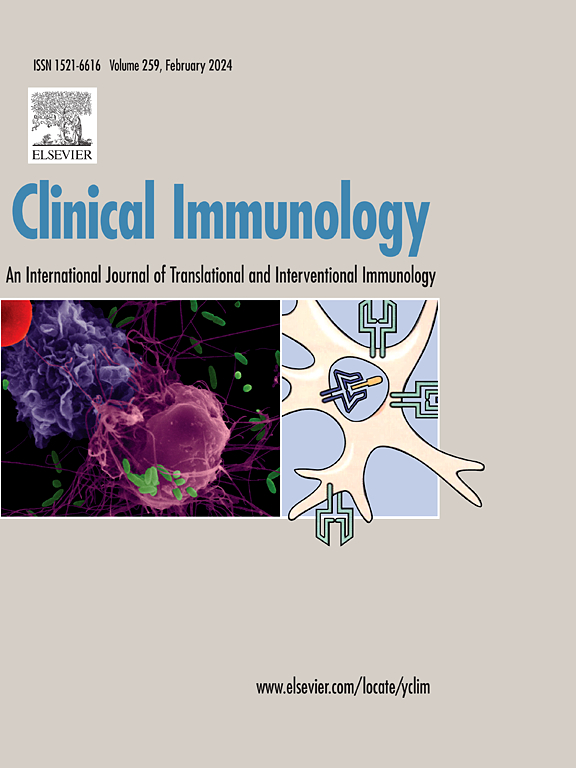NMDAR脑炎的外周t细胞亚群激活:疾病监测的发病机制和生物标志物潜力
IF 3.8
3区 医学
Q2 IMMUNOLOGY
引用次数: 0
摘要
n -甲基-d-天冬氨酸受体脑炎(NMDAR-E)是一种以神经精神症状和免疫失调为特征的严重自身免疫性疾病,涉及t细胞失调,但具体的t细胞亚群作用尚不清楚。本研究分析了外周血t细胞亚群作为监测和严重程度预测的生物标志物。方法采用流式细胞术对32例NMDAR-E患者、31例抗体介导性脑炎患者、26例病毒性脑炎患者和23例健康对照者的外周血进行分析。评估t细胞活化和共刺激的关键标志物。临床结果与免疫特征相关,以建立预测模型。结果与对照组相比,snmdar - e患者CD4+ t细胞活化升高,CD28、CD38和HLA-DR表达增加,表明免疫过度激活具有代偿性调节。基于t细胞的模型预测重症病例准确率高(AUC = 0.91)。结论cd4 + t细胞活化是NMDAR-E发病机制的核心,具有重要的诊断/治疗潜力。未来的研究必须在更大的队列中验证该模型,并解决外周血分析的局限性。本文章由计算机程序翻译,如有差异,请以英文原文为准。
Peripheral T-cell subset activation in NMDAR encephalitis: Insights into pathogenesis and biomarker potential for disease monitoring
Background
N-methyl-d-aspartate receptor encephalitis (NMDAR-E) is a severe autoimmune disorder characterized by neuropsychiatric symptoms and immune dysregulation ,involves T-cell dysregulation, but specific T-cell subset roles remain unclear. This study analyzed peripheral blood T-cell subsets as biomarkers for monitoring and severity prediction.
Methods
Peripheral blood samples from 32 NMDAR-E patients, 31 antibody-mediated encephalitis, 26 viral encephalitis patients, and 23 healthy controls were analyzed using flow cytometry. Key markers of T-cell activation and co-stimulation were assessed. Clinical outcomes were correlated with immune profiles to develop a predictive model.
Results
NMDAR-E patients showed elevated CD4+ T-cell activation, with increased CD28, CD38, and HLA-DR expression versus controls, indicating immune hyperactivation with compensatory regulation. The T-cell-based model predicted severe cases with high accuracy (AUC = 0.91).
Conclusion
CD4+ T-cell activation is central to NMDAR-E pathogenesis, highlighting diagnostic/therapeutic potential. Future studies must validate the model in larger cohorts and address peripheral blood analysis limitations.
求助全文
通过发布文献求助,成功后即可免费获取论文全文。
去求助
来源期刊

Clinical immunology
医学-免疫学
CiteScore
12.30
自引率
1.20%
发文量
212
审稿时长
34 days
期刊介绍:
Clinical Immunology publishes original research delving into the molecular and cellular foundations of immunological diseases. Additionally, the journal includes reviews covering timely subjects in basic immunology, along with case reports and letters to the editor.
 求助内容:
求助内容: 应助结果提醒方式:
应助结果提醒方式:


